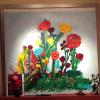





Correlative Theory(s) in relation to Einstein's Equilibrium Theorem & Hubble's Law;
Posted by
Darkly Origins
,
in
Biological/Mathematical Concepts
26 December 2014
·
2,875 views
relativity einstein topology physics hubbles law darwin evolution big bang theory big bang origins
 E=mc2 & Hubble’s Constant
E=mc2 & Hubble’s ConstantC = 186,000 miles per second: (exact value, rounded)
In relation: 0.999999999 (c2) X (Yi)| {h x r} 3.36 mc (au) | Hubble’s constant (Law)
In correlation: ----- 3.7x 10 (c3) X (Yi)| (6.71×108) | Einstein’s Equilibrium Theorem (Revds.)
Additionally; one would need multiply 9.999999999 (c2) X (Yi)| {h x r} 3.36 mc (au) and then divide the following by 3.7x 10 (c3) X (Yi)| (6.71×108) | whereas the sum would then be multiplied by C3 x 10 (eM) equilibrated to that of 1, 1, 12, 13, 16 (being in approximation,) equal to 1,000 megaparsec’s – wherein the given differentials in said variables is precisely befitted to the power of | I.H.Y.I | = E (for expansion, (€), being the singularity in the given variable as is characterized differently from traditional concept in algebraic topology, in differentials, in physical constancy, as concordantly to mine own innovated mathematical concept named: MMA’ meaning, “mixed mathematical applications.”) ').
Thus; the precipice of the (forever expanding space) has an infinitely and incalculably differential equation about it; that being in summarization: E=mc2/E=mc3 * 0.999999999 (c2) X (Yi)| {h x r} 3.36 mc (au) | * 3.7x 10 (c3) X (Yi)| (6.71×108) | * 9.999999999 (c2) X (Yi)| {h x r} 3.36 mc (au) / 3.7x 10 (c3) X (Yi)| (6.71×108) | * C3 x 10 (eM) = 1, 1, 12, 13, 16 approximately equal to {1,000 megaparsec’s} and thus;| I.H.Y.I | = E |
In conclusion, absolutely; there is but one singularity within all of existence; (one single-cell organism') in which is mathematically infinite, atomically, chemically and biologically concurrent – endless – bornless; this singularity is |absolute| and existed before the expanding universe; having sparked the “big bang” and through mathematical implication; it seems this singularity may have existed before the “big bang,” as numbers are infinite, so is this singularity-variable; having no beginning, nor ending – it’s intellectually incomprehensible, however – evidential through mathematical means of reasoning.;
The oddity in undefinable context remains; how can a singularity exist, mathematically – (also, applicable to the “Big Bang” (T.O.E) ')how a single-cell organism is and ever was possible if numbers are infinite, consequently meaning: variables, (;( irregardless of asymmetry, isotopic, design, conceptual classification, or contextual designation) )…are indeed infinite ;) thus having representative idealization in evidential factorization with – with evidential comprehensive means, (albeit, eerily in conceptual context ) that life’s origins, the cosmos, the placement of the planets, the stars, the astrophysical systems to which run all that is by ruling laws of physics – have palpability still; of course. Continued…
Cont. However, this privately newfound evidence has consistent mathematical basis with implications on the impossibility of reason: that is the “big bang,” thus – meaning there is but another explanation, (founded, or undiscovered, one can’t be sure, as it’s uncertain, and unknown, with conclusive feasibility in discernment and conception, if we’ve known, previously discovered, unveiled, etc. or, in contrast – have since dismissed old notions and ideals to which may better reiterate our understanding of our origins, be it “(a) god,” another scientific explanation, how dismissive of the “big bang,” yet, evolution still having profoundly conclusive, proving grounds in feasibility and/or credibility, meaning: evolution is by far, the closest thing to an absolute founded by humankind – in the humanistic,; it’s eerily curious, and darkly wondrous to think we haven’t all the answers to our origins; to think the “big bang” may be untrue, without accountability, feasibility, etc. Continued…
Cont. creating now, a gap of a sort, a gap in understanding, an unknown variable within a differentiated equation of a sort: say; unknown, then evolution, then unknown (;( second unknown representing fallacy in human thought patterning, not knowing where about the means of our ending as a species) ).);
Herein ends my impersonal contribution and accreditation in and of my thesis plot;
The following is a brief – yet, comprehensive explanation on Hubble’s Law’ for any unfamiliar readers.
The Hubble Constant is the unit of measurement used to describe the expansion of the universe. The cosmos has been getting bigger since the Big Bang kick-started the growth about 13.82 billion years ago. The universe, in fact, is getting faster in its acceleration as it gets bigger.
What's interesting about the expansion is not only the rate, but also the implications, as NASA explains on its website. If the expansion begins to slow down, that implies that there is something in the universe that is making the growth slow down — perhaps dark matter, which can't be sensed with conventional instruments. If the growth gets faster, though, it's possible that dark energy is pushing the expansion faster.
As of March 2013, NASA estimates the rate of expansion is about 70.4 kilometers per second per megaparsec. A megaparsec is a million parsecs, or about 3.3 million light-years, so this is almost unimaginably fast. Using data solely from NASA's Wilkinson Microwave Anisotropy Probe (WMAP), the rate is slightly faster, at about 71 km/s per megaparsec.
The constant was first proposed by Edwin Hubble (whose name is also used for the Hubble Space Telescope). Hubble was an American astronomer who studied galaxies, particularly those that are far away from us.
In 1929 — based on a realization from astronomer Harlow Shapley that galaxies appear to be moving away from the Milky Way — Hubble found that the farther these galaxies are from Earth, the faster they appear to be moving, according to NASA.
While scientists then understood the phenomenon to be galaxies moving away from each other, today astronomers know that what is actually being observed is the expansion of the universe. No matter where you are located in the cosmos, you would see the same phenomenon happening at the same speed.
Hubble's initial calculations have been refined over the years, as more and more sensitive telescopes have been used to make the measurements. These include the Hubble Space Telescope (which examined a kind of variable star called Cepheid variables) and WMAP, which extrapolated based on measurements of the cosmic microwave background — a constant background temperature in the universe that is sometimes called the "afterglow" of the Big Bang. [Infographic: Cosmic Microwave Background Explained]
Cepheid variables
There are many kinds of variable stars, but the one that is most useful for measuring the Hubble constant is called a Cepheid variable. These are stars that regularly change their apparent brightness on a scale that usually ranges between 2 and 100 days, according to NASA. (Polaris is among the most famous members of this group).
There also is a relation between the period of their brightness change, and their actual brightness, which means one can calculate the distance to the star. The brighter the Cepheid appears from Earth, the easier it is to measure it. Some Cepheid’s can even be seen from the ground, but for more accurate measurements, going into space is the best bet.
While Hubble was able to measure Cepheid’s about 900,000 light-years away — an astonishing distance for the time — within the universe that is still relatively close to Earth. Farther in space, the Cepheid’s are fainter and recede more quickly, which is where the Hubble Space Telescope was able to help in the 1960’s after its launch. (Citation needed )
Space telescope measurements
In 1999, astronomers announced a constant of 70 kilometers per second per megaparsec based on observations of nearly 800 Cepheid’s in 18 galaxies as far as 65 million light-years away from Earth. This pegged the universe at about 12 billion years old (which has since been refined to 13.82 billion years.) [Related: How Old is the Universe?]
"Before Hubble, astronomers could not decide if the universe was 10 billion or 20 billion years old," stated team leader Wendy Freedman of the Observatories of the Carnegie Institution of Washington in 1999 in the discovery news release. "After all these years, we are finally entering an era of precision cosmology. Now we can more reliably address the broader picture of the universe's origin, evolution and destiny."
Cepheid’s, however, are not perfect for this purpose. Among other difficulties, they are often located in dusty areas (which obscure some wavelengths in photographs) and the more distant ones are hard to spot because they are so faint from our perspective.
Other techniques arose to supplement Cepheid measurements, such as the Tully-Fisher relation, which describes the ratio of a spiral galaxy's rotational galaxy to its luminosity. WMAP used another technique that examines fluctuations in the cosmic microwave background to determine the constant.
Cited; (Elizabeth Howell, Nasa.gov Contributor).
Verily, Unapologetically,
Jacob A. Eder;
All Rights Reserved; 2011-2015; copyright protected:
(T3T Innovations); Jacob A. Eder; Darkly Origins/Eerie Flickering;































































This picture illustrates the relativity of simultaneity in Lorentz transformations. The three colored reference frames are associated to three different observers in relative motion along the x axis. Relative to the green observer, the red one is traveling at +0.28c and the blue one at −0.52c.